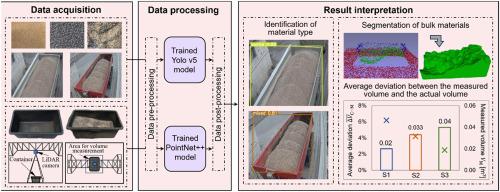Deep learning-based on-site identification and volume measurement of bulk material in construction industry
IF 8
2区 计算机科学
Q1 AUTOMATION & CONTROL SYSTEMS
Engineering Applications of Artificial Intelligence
Pub Date : 2025-10-21
DOI:10.1016/j.engappai.2025.112797
引用次数: 0
Abstract
Bulk materials are important raw construction materials, the adequate and precise supply of which enables a smooth construction process. Two conventional techniques for controlling the quantity of bulk materials on-site along the supply chain are: 1) estimation based on the cone-shape of the material pile, but the accuracy is low; 2) calculation by using bulk density and weighing stations, which are not available in all facilities. To address this issue, we propose a novel hybrid camera-based method combining a red-green-blue (RGB) camera and a light detection and ranging (LiDAR) sensor for automatic material type identification and volume measurement. The data from two-dimensional pictures and three-dimensional point cloud were segmented and extracted with two Deep Learning models: “You Only Look Once“ (YOLO) v5 and PointNet++for the identification of material type and volume measurement. This novel hybrid camera-based method was developed as an Industry 4.0 solution to enable the automatic and accurate evaluation of the volume of bulk materials. With a precision of 81.6 % in object recognition and a volume estimation deviation of less than 8 %, it provides a reliable and efficient alternative to conventional, labour-intensive measurement techniques.

基于深度学习的建筑行业散体材料现场识别与体积测量
散装材料是重要的建筑原材料,其充足和精确的供应使施工过程顺利进行。控制供应链现场散装物料数量的两种传统方法是:1)根据物料堆的锥形形状进行估计,但精度较低;2)利用容重和称重站进行计算,并非所有设施都有。为了解决这一问题,我们提出了一种基于混合相机的新方法,该方法将红绿蓝(RGB)相机与光探测和测距(LiDAR)传感器相结合,用于自动识别材料类型和体积测量。利用“You Only Look Once”(YOLO) v5和PointNet++两种深度学习模型对二维图像和三维点云数据进行分割和提取,用于材料类型识别和体积测量。这种新型的基于混合摄像机的方法是作为工业4.0解决方案开发的,可以自动准确地评估散装材料的体积。它在物体识别方面的精度为81.6%,体积估计偏差小于8%,为传统的劳动密集型测量技术提供了可靠和高效的替代方案。
本文章由计算机程序翻译,如有差异,请以英文原文为准。
求助全文
约1分钟内获得全文
求助全文
来源期刊

Engineering Applications of Artificial Intelligence
工程技术-工程:电子与电气
CiteScore
9.60
自引率
10.00%
发文量
505
审稿时长
68 days
期刊介绍:
Artificial Intelligence (AI) is pivotal in driving the fourth industrial revolution, witnessing remarkable advancements across various machine learning methodologies. AI techniques have become indispensable tools for practicing engineers, enabling them to tackle previously insurmountable challenges. Engineering Applications of Artificial Intelligence serves as a global platform for the swift dissemination of research elucidating the practical application of AI methods across all engineering disciplines. Submitted papers are expected to present novel aspects of AI utilized in real-world engineering applications, validated using publicly available datasets to ensure the replicability of research outcomes. Join us in exploring the transformative potential of AI in engineering.
 求助内容:
求助内容: 应助结果提醒方式:
应助结果提醒方式:


